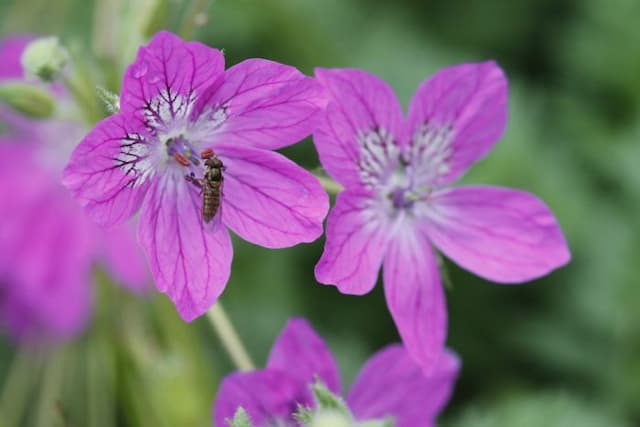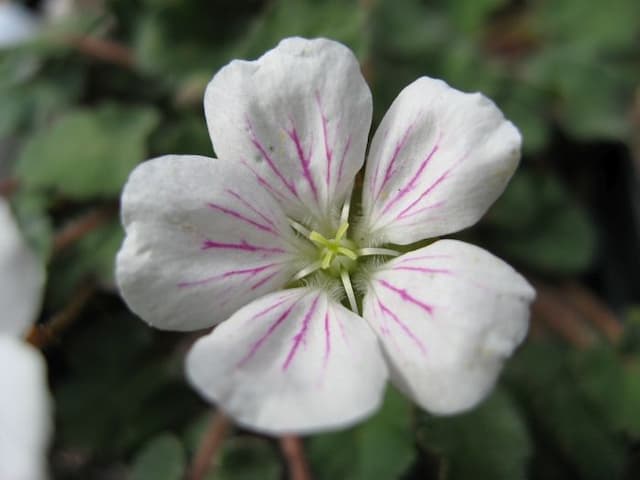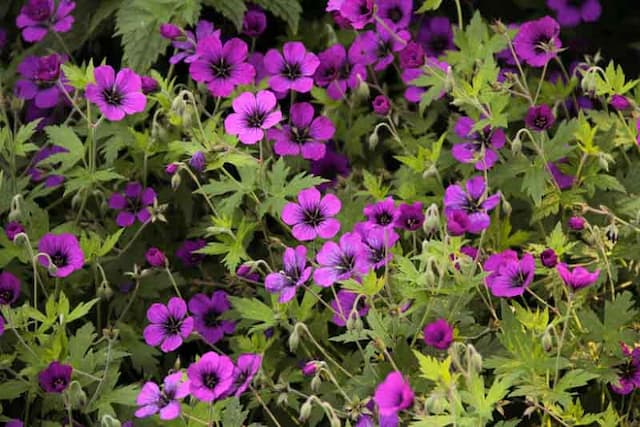Variegated Geranium Pelargonium 'Frank Headley' (Z/v)

ABOUT
Pelargonium 'Frank Headley', commonly known as geranium, is a visually striking plant characterized by its decorative foliage and vibrant blossoms. The leaves of this geranium are notably variegated; this means they display a combination of green and cream or white hues, often with distinct zonal markings, which are darker green areas typically in the shape of a horseshoe or ring. The flowers of the geranium 'Frank Headley' are a delightful sight to behold, with clusters of semi-double to double blooms that reveal a delicate pink to salmon coloring. Each petal is softly rounded, contributing to a full and lush floral display that emanates from the plant. The blooms are nestled above the ornamental foliage, which adds a wonderful contrast between the softness of the flowers and variegated pattern of the leaves. With a robust and bushy appearance, the geranium 'Frank Headley' has a full and dense growth habit, creating a substantial presence wherever it is planted. This plant's striking characteristics make it a popular choice for gardeners who wish to introduce both color and variegated texture to their garden spaces or containers.
About this plant
 Names
NamesFamily
Geraniaceae.
Synonyms
Variegated Geranium, Zonal Geranium.
Common names
Pelargonium 'Frank Headley'.
 Toxicity
ToxicityTo humans
The plant commonly known as geranium is generally considered non-toxic to humans. However, some people may experience mild irritation or an allergic reaction if they have sensitive skin. Ingesting parts of the plant is not typically harmful, but it may cause minor symptoms such as nausea, vomiting, or diarrhea in some individuals.
To pets
Geraniums are known to be toxic to pets, particularly to cats and dogs. If a pet ingests parts of a geranium, they may exhibit symptoms of poisoning that include vomiting, diarrhea, depression, anorexia, and dermatitis. In severe cases, ingestion could potentially lead to more serious reactions, and it is advisable to consult a veterinarian if you suspect your pet has consumed any part of the plant.
 Characteristics
CharacteristicsLife cycle
Perennials
Foliage type
Evergreen
Color of leaves
Variegated
Flower color
White
Height
1-2 feet (30-60 cm)
Spread
1-2 feet (30-60 cm)
Plant type
Herb
Hardiness zones
10
Native area
South Africa
Benefits
 General Benefits
General Benefits- Aesthetic Appeal: Pelargonium 'Frank Headley', commonly known as Geranium 'Frank Headley', offers attractive variegated foliage and showy flowers that can enhance the beauty of gardens and indoor spaces.
- Drought Tolerance: Geraniums are known for their ability to withstand periods of dryness, making them suitable for gardens in drier climates or for gardeners who prefer low-maintenance plants.
- Easy Propagation: They can be easily propagated from cuttings, allowing gardeners to rapidly expand their collection or share with friends and neighbors.
- Versatility: Geranium 'Frank Headley' can be grown in pots, containers, hanging baskets, or directly in the garden, offering flexibility in landscaping and garden design.
- Long Blooming Period: This plant often enjoys a long flowering season, providing consistent color and interest throughout the warmer months.
- Attracts Pollinators: The blooms of Geranium 'Frank Headley' can attract butterflies and bees, which are beneficial for pollinating other plants in the garden.
- Deer Resistance: Geraniums are generally not a preferred food source for deer, making them a good choice for gardens in areas where deer browsing is a problem.
- Ease of Care: Geranium 'Frank Headley' is low maintenance and does not require complex care routines, making it a good choice for novice gardeners.
- Compact Size: Its relatively compact growth habit makes it suitable for smaller gardens or spaces, as it doesn't overrun other plants.
 Medical Properties
Medical PropertiesThis plant is not used for medical purposes.
 Air-purifying Qualities
Air-purifying QualitiesThis plant is not specifically known for air purifying qualities.
 Other Uses
Other Uses- Botanical artwork subject: Geranium 'Frank Headley', with its variegated leaves and delicate blooms, can be a beautiful and intricate subject for botanical illustrators and artists seeking to capture the essence of ornamental plants.
- Garden photography: This particular cultivar of geranium, with its distinctive appearance, is ideal for garden photographers looking to showcase variety and contrast in plant portfolios or photographic collections.
- Educational tool: Geranium 'Frank Headley' can serve as a live example in horticultural and botanical education, enabling students to learn about variegation, hybridization, and plant care routines.
- Companion planting: In a mixed border or container garden, 'Frank Headley' can be paired with other plants to create visually appealing combinations and can potentially help deter pests due to its scented foliage.
- Color therapy gardens: The soothing shades of pink and white in the 'Frank Headley' blooms could be incorporated into healing gardens designed for color therapy and promoting a tranquil environment.
- Culinary presentation: Edible flowers of geraniums, including those of 'Frank Headley', may be used to adorn cakes and pastries, though should be used with caution if not confirmed for culinary use and always avoid using any plant not identified as safe for consumption.
- Scented sachets: Dried leaves of scented geranium varieties can be used in sachets to add a pleasant fragrance to drawers and closets, although 'Frank Headley' should be researched for its scent profile before such use.
- Crafting potpourri: The leaves and flowers of 'Frank Headley', particularly if they have a notable aroma, might be dried and included in potpourri mixtures to create a natural air freshener for indoor spaces.
- Textile dyeing: Geraniums, depending on their pigmentation, can sometimes be used in natural dye processes, although geranium 'Frank Headley' should be carefully tested for colorfastness and dye potential.
- Mood-enhancing décor: Adding 'Frank Headley' to interior spaces, such as offices, can enhance the room's aesthetics and, in turn, contribute positively to the mood and well-being of the people using the space.
Interesting Facts
 Feng Shui
Feng ShuiThe Geranium is not used in Feng Shui practice.
 Zodiac Sign Compitability
Zodiac Sign CompitabilityThe Geranium is not used in astrology practice.
 Plant Symbolism
Plant Symbolism- Comfort and Healing: Pelargoniums, commonly known as geraniums, often symbolize comfort due to their pleasant scent, which is used in aromatherapy to promote a feeling of relaxation and emotional healing.
- Good Health: Geraniums are believed to represent good health as they have been historically used in herbal remedies to treat a variety of ailments.
- Friendship: The longevity and hardiness of geraniums are associated with long-lasting relationships, making them a symbol of friendship and positive connections with others.
- Happiness and Positive Emotions: The bright blooms and ease of care contribute to their association with happiness, cheerfulness, and positive emotions.
 Water
WaterWater your Scented Geranium 'Frank Headley' deeply when the soil feels dry to the touch, which generally means approximately once a week during the active growing season, allowing the soil to moderately dry out between watering. During winter, reduce watering to every couple of weeks or as needed, merely to prevent the soil from completely drying out. Each watering session should be thorough enough to soak the top 6 to 8 inches of soil. To avoid water logging and root rot, ensure that your pot has adequate drainage holes. Depending on the pot size and environmental conditions, you might use up to half a gallon of water every two weeks during dormant periods, and up to one gallon per week during the growing season.
 Light
LightScented Geranium 'Frank Headley' thrives in bright, indirect light or partial sun. An ideal spot would be near an east or west-facing window where it can receive gentle morning or evening sunlight. Avoid placing it in direct, harsh afternoon sunlight as it can cause leaf scorch.
 Temperature
TemperatureScented Geraniums 'Frank Headley' prefer temperatures between 55°F and 75°F for optimal growth. They can survive minimum temperatures down to 30°F for short periods, but frost can damage the plant. Keep them away from cold drafts and protect them from temperatures exceeding 85°F, as extreme heat can stress the plant.
 Pruning
PruningPrune Scented Geranium 'Frank Headley' to maintain shape, encourage bushy growth, and remove any dead or yellowing leaves. The best time to prune is in early spring before new growth begins. Pruning can be done as needed throughout the growing season to promote a compact form and stimulate new growth.
 Cleaning
CleaningAs needed
 Soil
SoilGeranium 'Frank Headley' thrives in a well-draining potting mix rich in organic matter. A suitable soil recipe includes one part peat, one part perlite or sand, and one part loam, providing good aeration and drainage. The ideal soil pH for Geranium 'Frank Headley' is slightly acidic to neutral, ranging from 6.0 to 7.0.
 Repotting
RepottingGeranium 'Frank Headley' should be repotted every one to two years to refresh the soil and accommodate root growth. It is best to repot in spring before the start of the active growing season.
 Humidity & Misting
Humidity & MistingGeranium 'Frank Headley' prefers moderate to low humidity levels and can tolerate the dry air found in most homes. It is vital to avoid high humidity, which can lead to leaf and root rot.
 Suitable locations
Suitable locationsIndoor
Place in bright, indirect light and water when soil is dry.
Outdoor
Full sun to partial shade, protect from frost.
Hardiness zone
10-11 USDA
 Life cycle
Life cycleGermination begins when the seed of the Variegated Geranium is sown in well-draining soil with plenty of warmth and light, allowing it to sprout roots and shoots. Vegetative growth follows as the seedling develops into a mature plant with variegated green and white leaves, requiring regular watering, good sunlight, and occasional fertilization. Flowering occurs when the plant matures and environmental conditions are suitable, producing distinct salmon pink flowers that attract pollinators and add ornamental value. After pollination, the plant may produce seeds if conditions allow, which involves the development of seed pods that eventually dry and release seeds, completing the reproductive cycle. Throughout its lifetime, the Variegated Geranium may undergo pruning to shape the plant and remove dead or yellowing leaves, promoting healthier growth and more abundant flowering. The plant can live for several years with proper care, and it may enter a period of dormancy during colder months, requiring less water and ceasing growth until favorable conditions return.
 Propogation
PropogationPropogation time
Spring-Early Summer
The most popular method for propagating Pelargonium 'Frank Headley', commonly known as the Geranium 'Frank Headley', is through stem cuttings. This is usually done in the late spring to early summer when the plant is actively growing. To propagate through stem cuttings, a healthy, non-flowering shoot should be selected and a cutting of about 4 to 6 inches (approximately 10 to 15 cm) should be taken. The lower leaves are removed and the cut end is dipped in rooting hormone powder to encourage root growth. The cutting should then be planted in a pot filled with a well-draining soil mix, and watered lightly. The pot should be placed in a warm, bright location, but out of direct sunlight, and kept moist until roots have established, which can take a few weeks.









![Cranesbill [Rothbury Gem]](/_next/image?url=https%3A%2F%2Fplants-admin.emdemapps.com%2Fimages%2Fplants%2F%2Fimages%2F604b6243984c2.png&w=640&q=75)